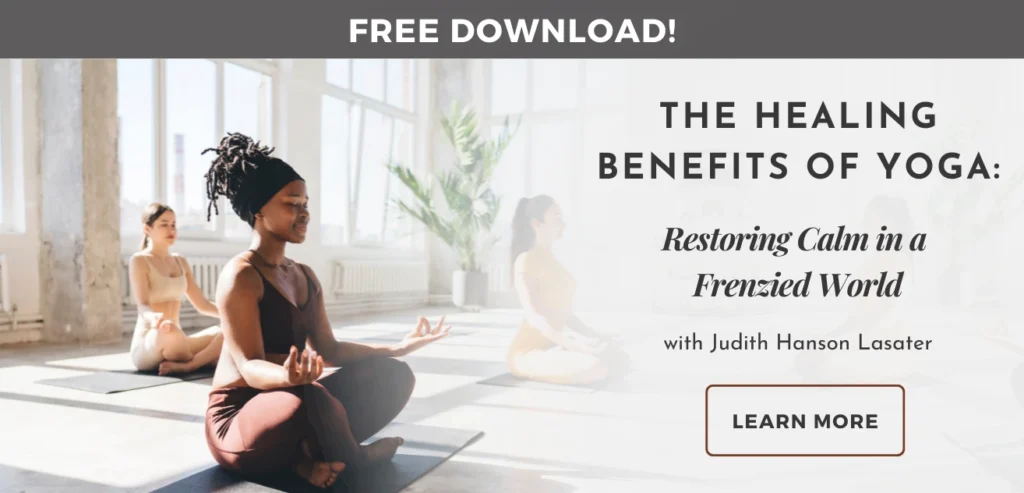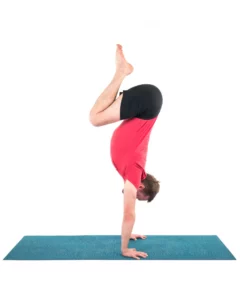How to Practice Yoga after Total Hip Replacement

Practicing yoga after total hip replacement introduces a new set of considerations.
- Your range of motion will be different immediately following your surgery.
- There will be movement restrictions post-surgery that will limit the kinds of poses you will be able to do. Restrictions may be lifted after six to twelve weeks, but can sometimes continue until six months or more after your surgery.
- Movement restrictions will differ depending on whether you’ve had anterior or posterior hip replacement. Your surgeon and physical therapist will give you guidelines as to which movements are safe and which you should avoid. Be sure to follow these guidelines to prevent displacement of your new hip joint.
- You may have lost strength in your core, leg muscles, and in the muscles around your hips. This can affect the stability of the hips.
How to Approach Yoga After Total Hip Replacement
Because your new hip is different from your old one, you will have to learn about the new ways that it can move. This takes time. Start by moving very slowly into your poses and stay aware of how your body responds. Start your exploration with Mountain Pose (Tadasana). It’s a launchpad for all other standing poses and a perfect place to start for total hip replacement. That’s because it establishes principles that support our hips as we move forward in our practice.
If you have restrictions, heed them to protect your new hips(s) and focus on strengthening the muscles that stabilize them. Practice standing poses and Chair Pose (Utkatasana) because standing poses provide the best of both worlds. With a standing pose, you first establish alignment and strength, which provides stability for your hips. This includes support when you move more deeply into a pose.
Types of Hip Movements in Yoga and How They Affect Total Hip Replacement
Consider the different categories of stretches and how they might affect total hip replacement:
1. Dynamic Stretching
This is when you are moving and stretching at the same time. An example of a dynamic stretch of the hamstrings and the hip flexors would be to balance on one leg while swinging the other leg forward and back. You can practice leg swings at the wall or beside a chair to support your balance. This is a good warm-up for a pose like Extended Hand to Big Toe Pose (Utthita Hasta Padangusthasana). In addition to stretching, this motion also strengthens these muscles.
Another dynamic stretching exercise for these muscles is walking. This motion also strengthens and warms up the hamstrings and hip flexors. Plus, it is a go-to exercise for post-total hip replacement recovery.
2. Static-Active Stretching
This is when you use the muscles near the joint to bring a limb or another body part into a stretched position.
An example of static-active stretching of the hamstrings in yoga is practicing the Extended Hand to Big Toe Pose, in which you balance one leg and use hip flexor muscles to lift and straighten the other leg in front of you.

Another example of static-active stretching of the hip flexors is when you practice Locust Pose (Salabhasana), where you lie on your belly and use your hamstrings to lift your legs to stretch the hip flexors. (image above)
Static-Passive Stretching

This is when you use gravity, your limbs, or some other aid to hold the stretched position.
An example of static-passive stretching is when you use a strap, your arms, or a chair to support the lifted leg in an Extended Hand to Big Toe Pose. (shown above with chair and strap)

An example of static-passive stretching of the hip flexors is when you practice Bow Pose (Dhanurasana). (shown above)
Static-passive stretching helps to attain a greater range of movement but carries a slightly higher risk of injury. Anytime you are “pulling” on your body to make it move into a certain shape, you are putting extra strain on your joints, tendons, and muscles. If you have had a total hip replacement, take care with static-passive stretching, especially when your hips are involved.
Rules of Thumb for Practicing Yoga After Total Hip Replacement

Follow these rules of thumb when approaching a stretch:
- For the safety of your total hip replacement, use static-active stretching as much as possible while getting to know your new hip(s). You will enjoy the benefits of a stretch while at the same time building muscle strength to stabilize your hips.
- Warm up the muscle(s) you want to stretch with dynamic stretching and with strengthening poses before you stretch. Stretching is safest when a target muscle is warmed up and when the area you want to mobilize has first been stabilized. By establishing stability, you reassure the body that you have created safe circumstances for deeper movement. For this reason, strengthening the main dish while stretching is a delicious go-with.
- It is hard to avoid static-passive stretches in some cases like when practicing Standing Forward Bend Pose (Uttanasana) where gravity is involved. Never “fall” into your poses. As gravity pulls you down, use your hamstring muscles, your core muscles, and/or your arm muscles with hands-on blocks to control your descent. Move slowly and respect your limits.
Also, read...
Stand Firm: 6 Easy Balancing Moves for Your Daily Yoga Routine
Dec 06 – By: Olga Kabel
The Many Benefits of Twists: 5 Great Yoga Postures for Low Back Health
Dec 03 – By: Sara Doyle, PhD, E-RYT 500
Desk-Friendly Yoga Neck and Shoulder Stretches
Dec 01 – Kathryn Boland, R-CYT, R-DMT
Related courses
Reprinted with permission from yogaforhipreplacement.com

Elizabeth Freeman (500 E-RYT, YACEP), founder of Yoga for Hip Replacement, has practiced yoga since 1985 and has been a yoga teacher since 1997. She specializes in yoga for people with movement challenges. Her students include those with a range of chronic issues, including Parkinson’s disease, multiple sclerosis, arthritis, and irritable bowel syndrome, as well as those recovering from hip, knee, and shoulder surgeries.
Motivated by her own experience with two hip replacements, she founded Yoga for Hip Replacement as a resource for people preparing for and recovering from hip surgery. She aims to offer safe and accessible yoga practices that support the best hip outcome.
Recent articles
4 Yoga Poses to Help Ease High Blood Pressure
Dec 08 – Stanley Clark
Stand Firm: 6 Easy Balancing Moves for Your Daily Yoga Routine
Dec 06 – By: Olga Kabel
Restorative Yoga: A Sequence to Build and Maintain Resilience
Dec 05 – By: Jennifer Willams-Fields, E-RYT 200
Categories
Upcoming courses
Reconnecting with Strength: Your Path to Building Greater Inner Resilience
With Arielle Schwartz
Recent articles
Almost there...
Sorry, we couldn't find anything...
Blood Pressure
4 Yoga Poses to Help Ease High Blood Pressure
Approximately 46 percent of Americans have high blood pressure, based on the American Heart…
Dec 08 – Stanley Clark
Yoga Practice Tips
Stand Firm: 6 Easy Balancing Moves for Your Daily Yoga Routine
My son loves to dig, so he zooms straight for the sandbox whenever we…
Dec 06 – By: Olga Kabel
Beginning Yoga
Restorative Yoga: A Sequence to Build and Maintain Resilience
Life is hard. Each day work, family, finances, and so much more can take…
Dec 05 – By: Jennifer Willams-Fields, E-RYT 200



